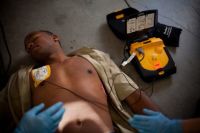From left to right, Jesús Ruiz-Ojeda (university professor at UPV/EHU), Elisabete Aramendi-Ecenarro, Digna María Gonzalez-Otero and Sofía Ruiz de Gauna-Gutierrez. (Image courtesy of UPV/EHU)
An algorithm capable of diagnosing heart rhythm with just 3 seconds’
worth of signal, and the demonstration that it is possible to come up
with the diagnosis without stopping cardiac massage, constitute the
types of solutions and proposals being developed by researchers in the
Signal and Communications Group of the Faculty of Engineering in Bilbao
(UPV/EHU-University of the Basque Country).
“We don’t save lives, we just do research,” as Jesús Ruiz, leader of
the Signal and Communications Group, makes it clear. “But what has been
confirmed is that it is cardiac massage that saves lives.” During a
cardiorespiratory arrest it is essential to apply immediately and
continuously thoracic compressions that ensure minimum blood perfusion
to the brain and the heart itself. And this is where the automated
external defibrillator (AED) plays an important role. They are simple
pieces of equipment that can be used by people with the minimum of
training, and are common in airports, shopping centres, sports centres,
etc. These devices analyse the patient’s cardiac rhythm and indicate to
the person assisting whether he/she has to move away for an electric
shock to be applied or whether he/she has to continue with the cardiac
massage.
The problem is that the thoracic compressions lead to interference
with the signal that the AED is picking up. As a result, the
compressions have to be stopped so that the equipment can reliably
diagnose the rhythm. Unfortunately, interrupting the compressions lowers
the patient's chances of survival. That is why over the last 15 years
work is being done to cut out this interference. However, as UPV/EHU
researchers have shown in a recent study published in The American
Journal of Emergency Medicine, at the moment the results are not
satisfactory. “The methods to cut out the interference are not yet good
enough,” points out Ruiz, the first author of the piece of work.
This piece of work includes the first methodology designed to quantify how often the massage is interrupted when a system for cutting out interference is applied. Current guidelines recommend stopping the compressions every two minutes to analyse the rhythm reliably. If the interference is cut out, it would be possible to make a diagnosis without stopping the massage, “but if the device inappropriately tells you to stop, because it has picked up a defibrillatable rhythm, and it turns out not to be the case, you may stop the compressions for longer than what is advised in the guidelines,” explains Ruiz. The study retrospectively analyses complete resuscitation actions recorded between 2003 and 2005 in three European localities. By applying the new methodology, it was concluded that “the state-of-the-art in interference cut-out systems leads us to a scenario in which more time is wasted as a result of mistakes in the diagnosis that what is established by the guidelines.”
In another article published in February in the journal
Resuscitation, Ruiz’ group proposes an alternative to cutting out the
interference: by taking advantage in the ventilation pauses to diagnose
heart rhythm. “The guidelines propose 2-minute cycles with intervals of
30 compressions, which are about 20 seconds, and 2 ventilations, which
are 5 seconds. And the article shows, for the first time, that it is
possible to take advantage of the ventilation intervals, in which there
is no interference, to make a reliable diagnosis. “That way we would
have a reliable diagnosis every 20 seconds; much more efficient than
what the rules state, which is every two minutes,” explains Ruiz.
To be able to make a diagnosis in these 5 seconds, they have applied a rapid algorithm, developed by the group. “While a normal algorithm takes 9 seconds' worth of signal to make a diagnosis, we have developed one that is very reliable and works with short signals. With the 3 seconds we can make a pretty reliable diagnosis,” points out Ruiz.
This algorithm has been introduced and is already being sold in the
R800 defibrillator produced by the company Osatu S. Coop. (Ermua,
Bizkaia, Basque Country) with which the group has been collaborating for
over 12 years. Osatu is a small co-operative that designs, manufactures
and markets AEDs and manual monitor-defibrillators under the brand name
Bexencardio (www.bexencardio.com). And around September they will be
launching another two models equipped with the same algorithm.
International collaboration
Despite the fact that nationally there are many research groups
working in the sphere of biomedical signals, the UPV/EHU’s Signal and
Communications Group is the only one working in the area of cardiac
resuscitation. So they have developed a network of international
collaboration with research groups based on the sharing of resources and
the carrying out of co-operative work. Among the main international
groups they are collaborating with mention should be made of the
research group Biomedical Data Analysis of the University of Stavanger
(Norway), the Institute for Experimental Medical Research of the
University Hospital of Oslo (Norway), and Philips Healthcare (Seattle,
USA).
Full bibliographic information
- Ruiz J., Ayala U., Ruiz de Gauna S., Irusta U., González-¬Otero D., Aramendi E., Alonso E., Eftestøl T. 2013. Direct evaluation of the effect of filtering the chest compression artifacts on the uninterrupted cardiopulmonary resuscitation time. The American Journal of Emergency Medicine, doi: /10.1016/j.ajem.2013.02.044 http://www.sciencedirect.com/science/article/pii/S0735675713001496
- Ruiz J., Ayala U., Ruiz de Gauna S., Irusta U., González-¬Otero D., Alonso E., Eftestøl T., Kramer-Johansen J. 2013. Feasibility of automated rhythm assessment in chest compression pauses during cardiopulmonary resuscitation. Resuscitation, JCR. doi: 10.1016/j.resuscitation.2013.01.034 http://www.sciencedirect.com/science/article/pii/S030095721300097X
Source: Elhuyar Fundazioa via AlphaGalileo



























